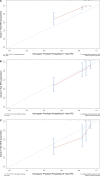Prognostic factors in breast phyllodes tumors: a nomogram based on a retrospective cohort study of 404 patients
- PMID: 29479819
- PMCID: PMC5911599
- DOI: 10.1002/cam4.1327
Prognostic factors in breast phyllodes tumors: a nomogram based on a retrospective cohort study of 404 patients
Abstract
The aim of this study was to explore the independent prognostic factors related to postoperative recurrence-free survival (RFS) in patients with breast phyllodes tumors (PTBs). A retrospective analysis was conducted in Fudan University Shanghai Cancer Center. According to histological type, patients with benign PTBs were classified as a low-risk group, while borderline and malignant PTBs were classified as a high-risk group. The Cox regression model was adopted to identify factors affecting postoperative RFS in the two groups, and a nomogram was generated to predict recurrence-free survival at 1, 3, and 5 years. Among the 404 patients, 168 (41.6%) patients had benign PTB, 184 (45.5%) had borderline PTB, and 52 (12.9%) had malignant PTB. Fifty-five patients experienced postoperative local recurrence, including six benign cases, 26 borderline cases, and 22 malignant cases; the three histological types of PTB had local recurrence rates of 3.6%, 14.1%, and 42.3%, respectively. Stromal cell atypia was an independent prognostic factor for RFS in the low-risk group, while the surgical approach and tumor border were independent prognostic factors for RFS in the high-risk group, and patients receiving simple excision with an infiltrative tumor border had a higher recurrence rate. A nomogram developed based on clinicopathologic features and surgical approaches could predict recurrence-free survival at 1, 3, and 5 years. For high-risk patients, this predictive nomogram based on tumor border, tumor residue, mitotic activity, degree of stromal cell hyperplasia, and atypia can be applied for patient counseling and clinical management. The efficacy of adjuvant radiotherapy remains uncertain.
Keywords: Adjuvant radiotherapy; clinicopathologic features; local recurrence; phyllodes tumor of the breast; surgical treatment.
© 2018 The Authors. Cancer Medicine published by John Wiley & Sons Ltd.
Figures





Similar articles
-
Malignant and borderline phyllodes tumors of the breast: a multicenter study of 362 patients (KROG 16-08).Breast Cancer Res Treat. 2018 Sep;171(2):335-344. doi: 10.1007/s10549-018-4838-3. Epub 2018 May 28. Breast Cancer Res Treat. 2018. PMID: 29808288
-
Predicting clinical behaviour of breast phyllodes tumours: a nomogram based on histological criteria and surgical margins.J Clin Pathol. 2012 Jan;65(1):69-76. doi: 10.1136/jclinpath-2011-200368. Epub 2011 Nov 2. J Clin Pathol. 2012. PMID: 22049216
-
Phyllodes tumor of the breast: stromal overgrowth and histological classification are useful prognosis-predictive factors for local recurrence in patients with a positive surgical margin.Jpn J Clin Oncol. 2007 Oct;37(10):730-6. doi: 10.1093/jjco/hym099. Epub 2007 Oct 11. Jpn J Clin Oncol. 2007. PMID: 17932112
-
Breast phyllodes tumor: a review of literature and a single center retrospective series analysis.Crit Rev Oncol Hematol. 2013 Nov;88(2):427-36. doi: 10.1016/j.critrevonc.2013.06.005. Epub 2013 Jul 17. Crit Rev Oncol Hematol. 2013. PMID: 23871531 Review.
-
Prognostic factors of breast phyllodes tumors.Histol Histopathol. 2023 Aug;38(8):865-878. doi: 10.14670/HH-18-600. Epub 2023 Feb 27. Histol Histopathol. 2023. PMID: 36866915 Review.
Cited by
-
Full-Thickness Chest Wall Resection and Reconstruction for Locally Invasive Phyllodes Tumors: A Systematic Review.Cancers (Basel). 2025 Jun 8;17(12):1907. doi: 10.3390/cancers17121907. Cancers (Basel). 2025. PMID: 40563558 Free PMC article. Review.
-
LncRNA ZFPM2-AS1 promotes phyllodes tumor progression by binding to CDC42 and inhibiting STAT1 activation.Acta Pharm Sin B. 2024 Jul;14(7):2942-2958. doi: 10.1016/j.apsb.2024.04.023. Epub 2024 Apr 24. Acta Pharm Sin B. 2024. PMID: 39027255 Free PMC article.
-
Recurrent borderline phyllodes tumor of the breast submitted to mastectomy and immediate reconstruction: Case report.Int J Surg Case Rep. 2019;60:25-29. doi: 10.1016/j.ijscr.2019.05.032. Epub 2019 Jun 5. Int J Surg Case Rep. 2019. PMID: 31195364 Free PMC article.
-
Borderline Phyllodes Breast Tumors: A Comprehensive Review of Recurrence, Histopathological Characteristics, and Treatment Modalities.Curr Oncol. 2025 Jan 26;32(2):66. doi: 10.3390/curroncol32020066. Curr Oncol. 2025. PMID: 39996866 Free PMC article. Review.
-
NKILA is a novel suppressor of local recurrence in women breast malignant phyllodes tumor patients via inhibition of the NF-κB pathway.Heliyon. 2024 Jun 20;10(13):e33259. doi: 10.1016/j.heliyon.2024.e33259. eCollection 2024 Jul 15. Heliyon. 2024. PMID: 39027510 Free PMC article.
References
-
- Tavassoli, F. A. 2003. Pathology and genetics of tumours of the breast and female genital organs. World Health Organization, international agency for research on cancer, international academy of pathology.
-
- Guillot, E. , Couturaud B., Reyal F., Curnier A., Ravinet J., Lae M., et al. 2011. Management of phyllodes breast tumors. Breast J. 17:129–137. - PubMed
-
- Hawkins, R. E. , Schofield J. B., Fisher C., Wiltshaw E., and McKinna J. A.. 1992. The clinical and histologic criteria that predict metastases from cystosarcoma phyllodes. Cancer 69:141–147. - PubMed
Publication types
MeSH terms
LinkOut - more resources
Full Text Sources
Other Literature Sources
Medical

